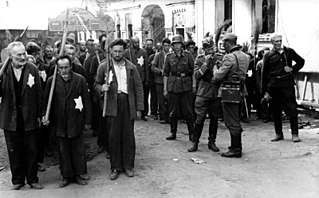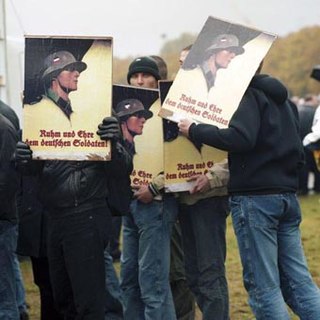Related Research Articles

Arthur Nebe was a German SS functionary who held key positions in the security and police apparatus of Nazi Germany and was, from 1941, a major perpetrator of the Holocaust.

A body count is the total number of people killed in a particular event. In combat, a body count is often based on the number of confirmed kills, but occasionally only an estimate. Often used in reference to military combat, the term can also refer to any situation involving multiple killings, such as the actions of death squads or serial killers.

The German invasion of the Soviet Union started on 22 June 1941 and led to a German military occupation of Byelorussia until it was fully liberated in August 1944 as a result of Operation Bagration. The western parts of Byelorussia became part of the Reichskommissariat Ostland in 1941, and in 1943, the German authorities allowed local collaborators to set up a regional government, the Belarusian Central Rada, that lasted until the Soviets reestablished control over the region. Altogether, more than two million people were killed in Belarus during the three years of Nazi occupation, around a quarter of the region's population, or even as high as three million killed or thirty percent of the population, including 500,000 to 550,000 Jews as part of the Holocaust in Belarus.

The Holocaust in Poland was the ghettoization, robbery, deportation, and murder of Jews in occupied Poland, organized by Nazi Germany. Three million Polish Jews were murdered, primarily at the Chelmno, Belzec, Sobibor, Treblinka, and Auschwitz II–Birkenau extermination camps, representing half of all Jews murdered during the Europe-wide Holocaust.

The Holocaust was the genocide of European Jews during World War II. Between 1941 and 1945, Nazi Germany and its collaborators systematically murdered some six million Jews across German-occupied Europe, around two-thirds of Europe's Jewish population. The murders were carried out primarily through mass shootings and poison gas in extermination camps, chiefly Auschwitz-Birkenau, Treblinka, Belzec, Sobibor, and Chełmno in occupied Poland.

During World War II, Soviet prisoners of war (POWs) held by Nazi Germany and primarily in the custody of the German Army were starved and subjected to deadly conditions. Of nearly six million that were captured, around three million died during their imprisonment.

Janowska concentration camp was a German Nazi concentration camp combining elements of labor, transit, and extermination camps. It was established in September 1941 on the outskirts of Lwów in what had become, after the German invasion, the General Government. The camp was named after the nearby street Janowska in Lwów of the interwar Second Polish Republic.

The myth of the clean Wehrmacht is the negationist notion that the regular German armed forces were not involved in the Holocaust or other war crimes during World War II. The myth, heavily promoted by German authors and military personnel after World War II, completely denies the culpability of the German military command in the planning and perpetration of war crimes. Even where the perpetration of war crimes and the waging of an extermination campaign, particularly in the Soviet Union – where the Nazis viewed the population as "sub-humans" ruled by "Jewish Bolshevik" conspirators – has been acknowledged, they are ascribed to the "Party soldiers corps", the Schutzstaffel (SS), but not the regular German military.

The 201st Security Division, originally the 201st Security Brigade, was a German Army rear-area security division of World War II. The unit was deployed in German-occupied areas of the Soviet Union, and was responsible for large-scale war crimes and atrocities including the deaths of thousands of Soviet civilians. It was disbanded in January 1945

Max von Schenckendorff was a general in the Wehrmacht of Nazi Germany during World War II. He was the commander of Army Group Rear Area behind Army Group Centre from March 1941 until his death. He is best known for organising the Mogilev conference, in which Wehrmacht and SS officers discussed "bandit fighting" tactics, meaning the mass murder of Jews and other real or perceived enemies. The conference resulted in an intensification of the genocide that was already taking place in Army Group Centre Rear Area.
The 221st Security Division was a rear-area security division in the Wehrmacht during World War II. Commanded by General Johann Pflugbeil, the unit was deployed in German-occupied areas of the Soviet Union, in the Army Group Centre Rear Area, for security and Bandenbekämpfung ("anti-bandit") duties. It was responsible for large-scale war crimes and atrocities including the deaths of thousands of Soviet civilians.
The 203rd Security Division, was a rear-security division in the Wehrmacht of Nazi Germany. The unit was deployed in German-occupied areas of the Soviet Union, in the Army Group Centre Rear Area and was responsible for large-scale war crimes and atrocities.
The Mogilev Conference was a September 1941 Wehrmacht training event aimed at improving security in the rear of Army Group Centre during the German invasion of the Soviet Union. The event was organised by General Max von Schenckendorff, commander of Army Group Centre Rear Area, in cooperation with the officials of the security and intelligence services of Nazi Germany—SS and the Sicherheitsdienst —operating in the same area. Ostensibly an "anti-partisan" training conference, the event marked an escalation of violence against Jews and other civilians in the areas under Schenckendorff's command.

Marching into Darkness: The Wehrmacht and the Holocaust in Belarus is a book by the American historian Waitman Wade Beorn, published in 2014 by Harvard University Press. It discusses the participation of the German Wehrmacht in the Holocaust and other crimes against humanity during the course of the early stages of the German-Soviet War (1941–45).

Franz von Roques was a German general during World War II. He was the commander of Army Group North Rear Area behind Army Group North from March 1941 to April 1943.

Erich Friderici was a German general during World War II. He was the commander of Army Group South Rear Area behind Army Group South from 27 October 1941 to 9 January 1942, while the original commander, Karl von Roques, was on medical leave.

In German military history, Bandenbekämpfung, also referred to as Nazi security warfare during World War II, refers to the concept and military doctrine of countering resistance or insurrection in the rear area during wartime with extreme brutality. The doctrine provided a rationale for disregarding the established laws of war and for targeting any number of groups, from armed guerrillas to civilians, as "bandits" or "members of gangs". As applied by the German Empire and later Nazi Germany, it became instrumental in the crimes against humanity committed by the two regimes, including the Herero and Nama genocide and the Holocaust.

Waitman Wade Beorn is an American historian and former military officer who specializes in Holocaust studies, focusing on the Holocaust in Eastern Europe. He is currently an Assistant Professor in History at Northumbria University in Newcastle upon Tyne. Beorn previously served as the Louis and Frances Blumkin Professor of Holocaust and Genocide Studies at the University of Nebraska Omaha. From 2015 to 2016, he was the executive director of the Virginia Holocaust Museum in Richmond, Virginia.
The Police Battalion 322 was a formation of the German Order Police during the Nazi era. During Operation Barbarossa, it was subordinated to the SS and deployed in German-occupied areas, specifically the Army Group Centre Rear Area, of the Soviet Union, as part of Police Regiment Centre.
Hostage shootings in Serbia was a policy introduced by the German occupiers of Serbia during World War II in reprisal for Yugoslav Partisan activity. A large number of ethnic Serbs, Romani people, and Serbian Jews were shot in executions such as the Kraljevo massacre and Kragujevac massacre. These shootings were punished as war crimes during the Hostages trial.
References
- ↑ Kay 2021, p. 283.
- ↑ Kay 2021, p. 282.
- ↑ Kay 2021, p. 284.
- ↑ Kay 2021, p. 2.
- ↑ Nolte, Hans-Heinrich (2021). "Alex J. Kay: Empire of Destruction. A History of Nazi Mass Killing, New Haven/CT u. London: Yale University Press, 2021, 378 S. ISBN 978-0-23405-3". Zeitschrift für Weltgeschichte. 22 (1–2): 382–387.
- ↑ Rowe-McCulloch, Maris (2022). "Empire of Destruction: A History of Nazi Mass Killing". German History. 40 (4): 610–612. doi:10.1093/gerhis/ghac046.
- ↑ Beorn, Waitman Wade (2022). "Empire of Destruction: A History of Nazi Mass Killing. By Alex J.Kay. Yale University Press, 2021 xix + 376pp. HB. £25.00". History. 107 (376): 602–603. doi:10.1111/1468-229X.13293.